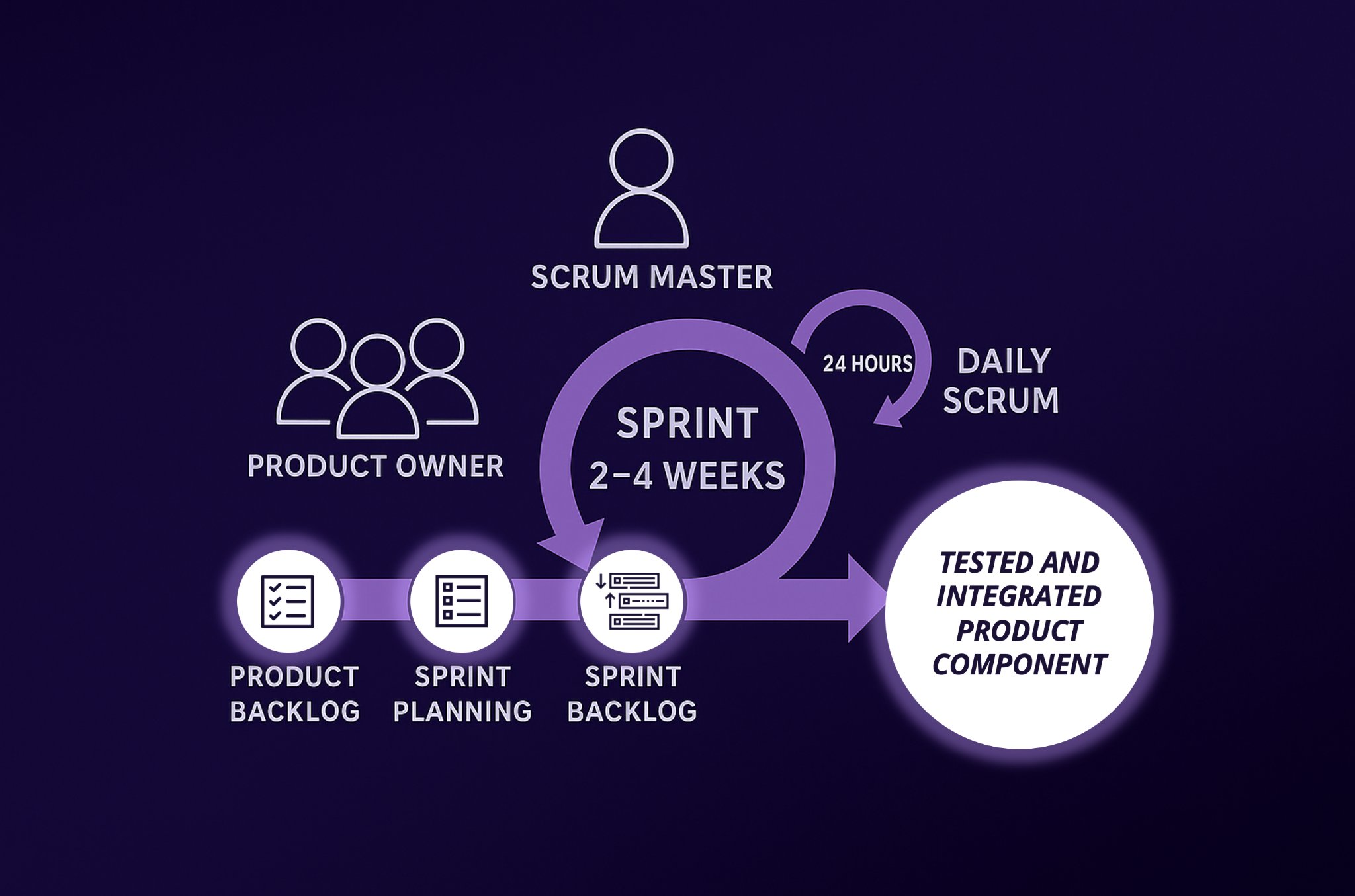
What is a Scrum Team?
A Scrum Team is a small, self-organizing, and cross-functional unit that works together toward a common product goal. Typically limited to ten members or fewer, the team structure ensures efficient communication and high productivity. There are no hierarchies or sub-teams within the Scrum Team – everyone shares equal responsibility for the team's success.
The Three Scrum Team Roles
1. Product Owner: The Voice of the Customer
The Product Owner is responsible for maximizing the value of the product resulting from the team’s work. They manage the Product Backlog, prioritize tasks based on customer needs and business goals, and ensure that the team is always working on what matters most.
2. Scrum Master: The Process Facilitator
Acting as a servant leader and coach, the Scrum Master supports the team in applying Scrum effectively. They remove obstacles, promote a culture of continuous improvement, and protect the team from outside interruptions to ensure a productive work environment.
3. Developers: The Implementation Experts
Developers are the team members who create the product increment. They are responsible for planning and executing the Sprint goals, maintaining quality standards, and continuously adjusting their work to meet the Sprint objective. The team is self-organizing and decides independently how best to complete the work.
Collaboration Within the Scrum Team
An effective Scrum Team thrives on close collaboration, open communication, and mutual trust. Regular Scrum events such as the Daily Scrum, Sprint Planning, Sprint Review, and Sprint Retrospective foster exchange and continuous improvement. The following image illustrates how the Scrum process works.

1. Product Backlog
The Product Owner collects all tasks and requirements in a list – the Product Backlog. This includes everything that might need to be done in the future.
2. Sprint Planning
Before each sprint, the team jointly decides which tasks from the backlog they want to implement next. This selection process is called Sprint Planning.
3. Sprint Backlog
The selected tasks are added to the Sprint Backlog. These are the tasks the team will focus on during the upcoming sprint.
4. Sprint (2–4 weeks)
The sprint begins. Over the course of 2 to 4 weeks, the team works on the selected tasks. During this time, a short daily meeting – the Daily Scrum – helps the team stay aligned.
5. Scrum Master & Product Owner
The Scrum Master supports the team and ensures that everything runs smoothly. The Product Owner represents the customers' or users’ perspective.
6. End of the Sprint
At the end of the sprint, there is a finished, tested product component. It can be used immediately or further developed. Then the next sprint begins.
Benefits of a Scrum Team
- Transparency: Progress is always visible through regular meetings and clear artifacts like the Product Backlog.
- Flexibility: The team can quickly adapt to change and adjust priorities.
- Customer Focus: Delivering value to the customer remains the central objective.
- Continuous Improvement: Frequent retrospectives help the team learn and improve its workflow continuously.
Conclusion
A well-functioning Scrum Team is the cornerstone of successful agile product development. With clear roles, strong collaboration, and a structured process, it creates the foundation for delivering high-quality products tailored to customer needs.
At mesoneer, we consciously take a different approach: our teams are leaner, more focused, and more efficient – typically consisting of four experienced developers and a dedicated Product Owner, known as a Solution Manager. We deliberately choose not to include a Scrum Master. Instead, our teams take full responsibility for the process themselves. They work closely with our clients to identify obstacles early and resolve them pragmatically.
Frequently asked questions
In Scrum, the team regularly selects tasks from a list (the backlog), works on them independently during a Sprint, and discusses progress daily. After each Sprint, the results are reviewed and the process is adjusted.
No, the Scrum Master is not a traditional leader. They help the team work effectively, remove obstacles, and ensure the Scrum rules are followed.
Scrum artifacts are key work tools:
- Product Backlog (all tasks),
- Sprint Backlog (tasks for the Sprint),
- Increment (the finished work result).
They ensure transparency and make progress visible.
The five Scrum values are:
- Commitment,
- Courage,
- Focus,
- Openness,
- Respect.
Scrum includes five key events:
- Sprint – a time frame (usually 2–4 weeks) for delivery,
- Sprint Planning – the team plans the upcoming work,
- Daily Scrum – a short daily meeting to coordinate,
- Sprint Review – presentation and feedback on the result,
- Sprint Retrospective – reflection to improve collaboration.
Scrum is not a typical acronym. The term comes from rugby and refers to tight teamwork – transferred to agile project work.
A Scrum Master is responsible for helping the Scrum Team perform well. They support the team, resolve issues, protect it from outside disruptions, and promote adherence to Scrum principles.
Scrum is a method where teams work in small steps (called Sprints) to gradually develop or improve a product or project. It focuses on collaboration, feedback, and constant adaptation.
Want to implement agile product development quickly and efficiently without the hassle of assembling a new team?
With our Scrum Team as a Service, we provide experienced, high-performing Scrum Teams - flexible, scalable, and ready to hit the ground running.
Related Blog Posts





